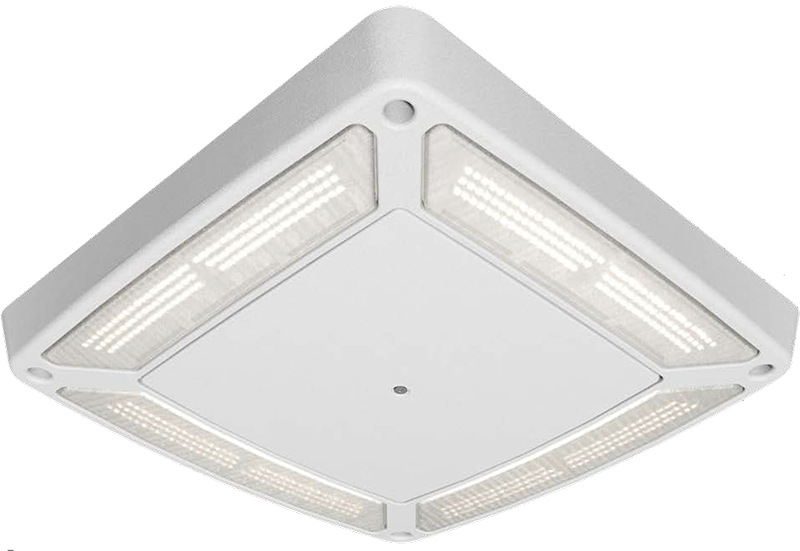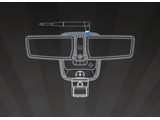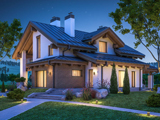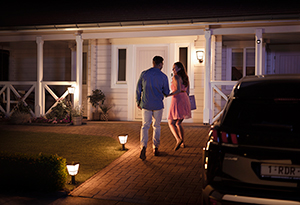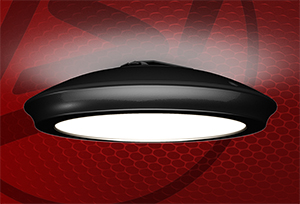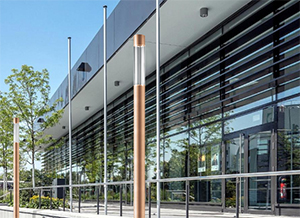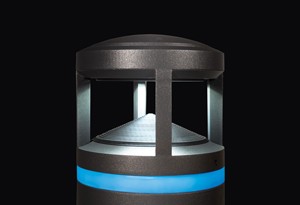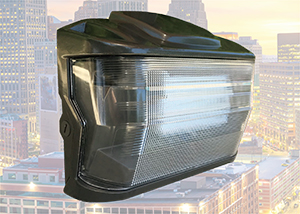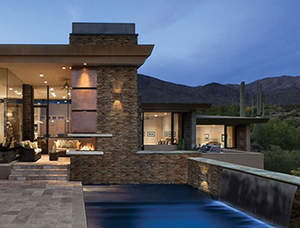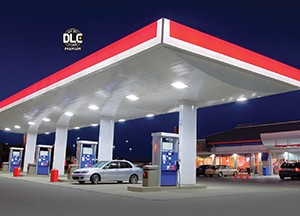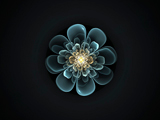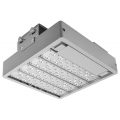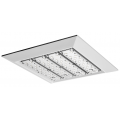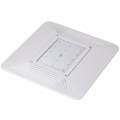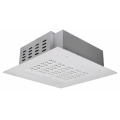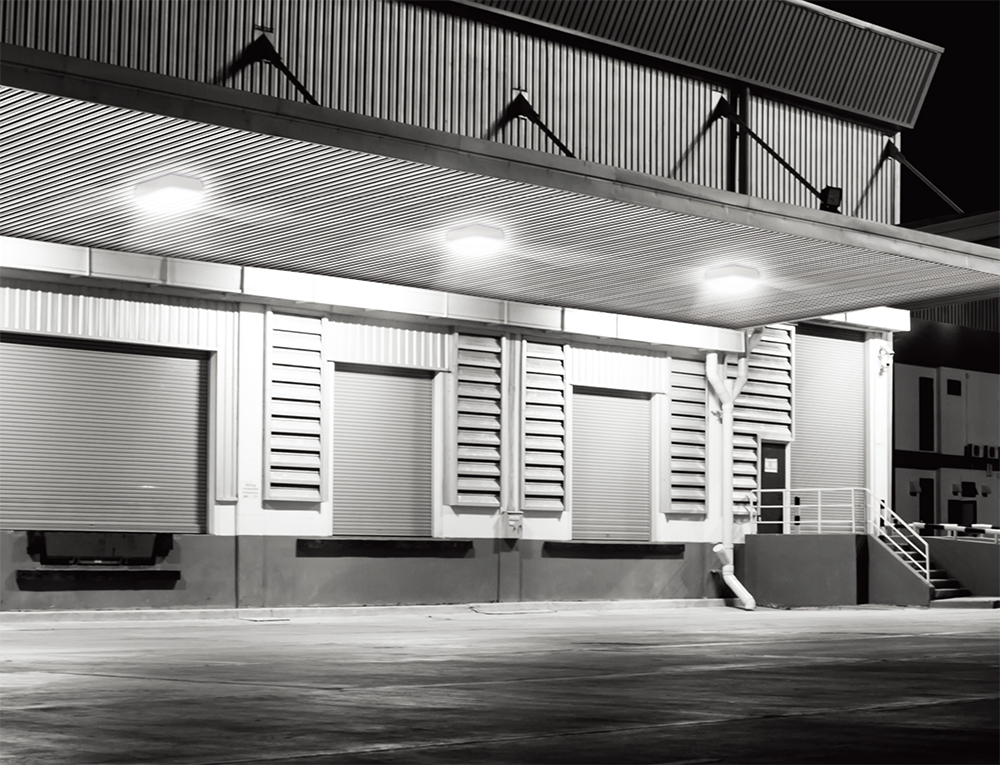
Image courtesy of Cree Lighting
Canopy lights are outdoor ceiling lights that provide a downward and outward distribution of light for area illumination underneath architectural canopies. These light fixtures are mounted to overhead canopy structures of outdoor commercial and retail facilities. Perhaps the most common use of canopy lights is for gas stations. Canopy lights are also the choice of light fixture for drive-through restaurants, loading docks, truck stops, storefronts for convenience stores, and other covered areas where overhead lighting is desirable. These ceiling fixtures are either surface-mounted to their support structures or designed for recessed installation in single or double skin canopies.
Luminaire Design
Solid state lighting based on LED technology is a game changer. It has profoundly changed the way luminaires are built. LEDs provide ample design flexibilities. The compactness of LEDs significantly scales down the volume of luminaires and lends canopy luminaires a low profile design. As such, even a surface-mounted LED luminaire can provide maximum clearance, aside from its sleek architectural appeal. LED canopy lights either come with a self-contained system that incorporates all functional components into an enclosure, or are designed to separate the light assembly from the driver which is housed in a dedicated electrical box. Self-contained LED canopy lights feature a box-like shape. Those operated by external drivers typically have the luminaire housing designed in a panel shape. This allows the luminaire to be minimally visible from below a ceiling and to adhere to strict height restrictions. The electrical box mounts above the canopy to keep wiring and driver components safely away from trapped water and debris. An opening must be made in the canopy to receive the electrical box or junction box.
Construction
Most LED canopy lights have a rugged die cast aluminum construction. Perimeter heat sink fins may be integrally cast into the housing to maximize heat dissipation. The housing and electrical box are finished with a fade, corrosion and abrasion resistant TGIC polyester powdercoat paint. A gasketed, UV stabilized acrylic or tempered glass lens seals the LEDs from the outside environment. All entry points and material transition of the optical compartment and electrical box/compartment should be thoroughly sealed to provide ingress protection against water and dust. High watertight integrity of the optical compartment is particularly important for outdoor LED luminaires. Ingress of water and long term exposure to water vapor will cause absorption and diffusion of moisture in silicone encapsulant of the LED packages. Presence of moisture in silicone will accelerate the kinetics of degradation reaction under hygromechanical stresses. The consequences of moisture-polymer reactions include fast LED lumen depreciation and chromaticity shifts. Preferably the optical compartment should be sealed to a minimum IP66 rating. LED canopy lights are exposed to environmental temperature changes and operate at high case temperatures. A rapid change of temperature will create pressure differentials between the enclosure and its environment. The pressure differentials could put a significant stress on the seals. To protect the seal against premature failure due to repeated temperature cycling, the luminaire housing incorporates a screw-in membrane vent which equalizes pressure by allowing air to pass through the microporous membrane while blocking water and contaminants.
LED Assembly
The light assembly of an LED canopy light can be a single LED board or an assembly of multiple LED modules. The vast majority of products use SMD LED packages which are reflow soldered onto a metal core printed circuit board (MCPCB). The integrity of the LED-substrate-to-PCB solder joint is especially a priority in LED system engineering because a damaged or faulty solder joint can cause an open circuit failure under harsh operating conditions such as repeated vibration and thermal cycling. The key determinants of high reliability solder joints include the metallurgical quality of solder alloys, metallization of the LED package and PCB, reflow profile, and interconnection-level coefficient of thermal expansion (CTE) match.
The economics and efficacy advantages of plastic leaded chip carrier (PLCC) packages make them the most widely used light source in middle wattage lighting systems. The broad adoption of PLCC LED packages in indoor markets has led to the development of a rich manufacturing ecosystem that significantly drives down the cost. These mid-power LEDs, however, are prone to performance degradation and premature failure in outdoor applications. Canopy structures are primarily designed to accommodate vehicular traffic. Sulfur compounds in vehicular emissions can diffuse into the LED package and react with silver leadframe plating. The silver layer transforms into silver sulfide, which causes the lead frame to lose reflectance. Over time the corrosion leads to an open contact because silver sulfide is not electro-conductive. A mechanical separation between the bond wire and the connecting lead may occur due to vibration caused by reverberation of heavy vehicles passing canopy facilities. The high luminous efficacy of PLCC packages is also contributed to by a reflective plastic housing which can be made from polyphthalamide (PPA), polycyclohexylenedimethylene terephthalate (PCT) or epoxy molding compound (EMC). Under high drive currents or thermal loads, these materials are susceptible to reflectance determination and discoloration. For canopy lights intended to use mid-power LEDs, definitely go for thermally enhanced EMC packages with Quad Flat No-lead (QFN) anode/cathode pads if the budget allows.
Wattage of LED canopy lights ranges from 20W to 200W. In high wattage systems ceramic-based high power LED packages usually outperform mid-power LEDs and offer a better return on investment (ROI) despite their high first costs. High lumen LED systems typically operate at a junction temperature in excess of 100°C which exceeds the characteristic temperature limit of mid-power LEDs. The optical power and dependability of high power packages can be attributed to a high efficiency, high reliability thermal management platform that enables the LEDs to perform optimally even they are stressed by high drive currents and junction temperatures.
Chip-on-board (COB) LED packages are also found in canopy lighting systems but their market share is low. COB LEDs, with a multi-die array design and the ability to produce thousands of lumens from a single package, drastically simplifies circuit and optical design. However, COB LEDs are limited to applications where precise light distribution is not a priority while wide light distribution is desired. They underperform ceramic-based high power LEDs in terms of high temperature, high drive current capabilities, nor are they comparable to mid-power packages with regard to efficacy and cost.
Spectral Characteristics
LED canopy lights, which can be thought of as outdoor ceiling lights, differ significantly from their indoor counterparts in aspects such as fixture design, optical control, ingress protection, and weatherability. The spectral power distribution (SPD), which determines how the light appears and also how object colors are rendered, also varies a lot between light sources used in indoor and outdoor luminaires. In contrast to indoor lighting that attaches more importance to color discrimination and visual perception, outdoor lighting puts more weight on visual acuity.
Typically, the light source correlated color temperature (CCT) for canopy lights falls in the range of 4000 - 5500 K. This is because the high percentage of blue wavelengths in high CCT cool white light contributes to better object recognition in low light (mesopic) conditions. The correlation of SPD and mesopic vision can be described by the scotopic/photopic (S/P) ratio. Cool white light has a higher S/P ratio than warm white light, and accordingly a better visual acuity. For warm white light to achieve the same level of visual acuity as with cool white light, a higher lumen package is required. This in turn waste energy. Since high illuminance may pose adaptation problems for people leaving the canopy facility and re-entering the much darker street or roadway nearby, canopy lighting is typically designed to deliver a moderate level of illuminance without producing a high contrast to the surrounding (maximum uniformity ratio 5:1). Under this circumstance, high CCT light sources are in an advantageous position as they can produce light to maintain an adequate level of visual acuity at a relatively low illuminance level as opposed to warm white light sources.
When it comes to spectral quality, light with a minimum CRI Ra of 70 may accomplish the basic color discrimination requirements in outdoor environments. When canopy lighting is designed to provide illuminance for retail and exhibition applications, light sources capable of rendering all critical colors will be a necessity.
Optical Design
LED canopy lights come with diversified levels of photometric control. SMD LEDs can be mounted onto a circuit board in an array pattern that produces uniform illumination without using secondary optics. However, in outdoor environments where lighting should be coordinated with the surrounding background, uniform light distribution, precise direction of the light to intended area, and a high level of visual comfort are frequently concurrent requirements. Too often, canopy lighting demands high levels of both horizontal and vertical illuminance. For example, in service stations not only uniform horizontal illuminance is important for task visibility and general circulation, high vertical illuminance is also required in order for a store clerk to monitor activity at the dispensers. While entering the dispenser island area, minimizing glare from overhead canopy lights will help address similar adaptation problems as well.
The simplest way to soften the harshness of LEDs and uniformly distribute light to use diffusers or prismatic refractors. To improve vertical illuminance, the diffuser or refractor may be designed as drop lenses. When light trespass is an issue of concern, precision design compound lenses can be used to produce tightly controlled candela distributions. Total internal reflection (TIR) optics are a type of high efficiency optical solutions commonly used in outdoor luminaires to minimize secondary solid angles for reduced glare and light trespass while producing precise, uniform light distributions. TIR optics are injection molded from acrylic or polycarbonate and designed as an integral lens array. The lens array is indexed to the circuit board with high axial placement accuracy.
Thermal Management
Thermal management of LED canopy lights is intended to maintain the optical performance of LEDs and system functionality throughout the rated life of the luminaires. In LED lighting, the conversion from electrical power to optical power produces a significant amount of waste energy that is localized in the semiconductor light source as heat. Thermal buildup within the LEDs can accelerate the atomic defect growth, discoloration of packaging materials, and degradation in phosphor efficiency. Thermal degradation is accompanied by irreversible lumen depreciation and color shifts as well as a reduction in LED life. Thermal management is one of the key determinants of long-term performance maintenance and reliability of LED luminaires.
To ensure that the thermal transfer rate outpace the thermal load rate, the thermal resistance of the components along the thermal path from junction to air as well as the length of the thermal path should be reduced to a minimum. It is essential that the MCPCB has high thermal conductivity yet still offers high dielectric strength for electrical isolation. The form factor of LED canopy lights allows to accommodate a MCPCB which provides a large surface area to spread the heat generated by the array of LEDs. Products with external drivers provide more efficient thermal conduction because these low profile systems enable direct thermal interfacing of the MCPCB and heat sink. A thermal interface material (TIM) can be used to minimize the interfacial contact resistance between the circuit board and heat sinking surface. The performance of the heat sink, in addition to making use of high thermal conductivity material such as aluminum, strongly depends on the boundary conditions and geometry. The die casting process allows aluminum heat sinks to be designed with good aerodynamics and a maximum surface area that facilitate convective cooling.
LED Driver
An LED driver is a power supply intelligent to forward voltage drop, supply voltage or load variations. It produces outputs that respond to the precise power requirements of the current driven LEDs and ensures that the LEDs are driven with tightly matched electrical characteristics. It is also essential that the electrical conversion efficiency of the power supply to drive the LEDs is optimized. A low efficiency driver not only produces a huge power loss, the heat dissipated from the waste power can produce a high thermal stress to co-located LEDs. The components within the driver are also prone to premature failures as they operate at a higher temperature.
LED canopy lights are generally equipped by switch-mode power supplies (SMPS) which operate by switching energy storage elements. The current supplied to the LED load is controlled by adjusting the switching frequency or duty cycle. This mode of operation ensures the driver operates with minimal power loss, provides tight load regulation, and enables accurate current control for dimming operation. The greatest problem with the SMPS is high frequency switching regulation generates electromagnetic interference (EMI). The conducted electromagnetic emissions must be suppressed by additional circuits. Power factor correction (PFC) is required to maintain high power factor and low total harmonic distortion (THD) over a wide input voltage range. Isolated drivers include a transformer that performs galvanic isolation for powering from the AC grid.
A large percent of LED system failures is caused by LED drivers. Electrolyte capacitors, which act as energy storage and filtering elements, are typically the weakest point among all driver components as the electrolyte evaporation rate depends upon the temperature inside the driver. Use of high temperature capable capacitors and efficient thermal management of the driver circuits are two vital components in system design. Output protection, including over-current, over-voltage and short circuit protection, is implemented on the driver to prevent damage to both the circuitry and LEDs. In addition, most LED drivers are equipped with over-temperature protection (OTP) to minimize the risk of thermal overload due to operation of the device with high load or inadequate cooling. A surge protection module is typically incorporated for effective suppression of most transient AC line surges.
Dimmable LED drivers are capable of interpreting control signals and dimming the LEDs accordingly. These drivers may include analog dimming circuitry based on the constant current reduction (CCR) technique and/or a pulse-width modulation (PWM) circuit. Analog dimming circuits may be controlled through a wide variety of protocols, such as 0-10V, DALI, and ZigBee. PWM circuits also allow users to control with a 0-10 V dimmer. Some drivers are compatible with conventional dimmers, such as triac dimmers.
Photocells and occupancy sensors may be added to canopy luminaires and provide feedback to the driver circuit, enabling dusk-to-dawn control and presence detection for maximized energy savings.
Featured Products
Here's a roundup of some noteworthy products for your reference. (Disclaimer: We're not affiliated with any beneficiary of the external product links in this list.) This is a continuously updated list. We welcome product suggestions from those who take pride in building compelling value into their products. (Owners of products listed here are authorized to use our badge to promote your achievement. Please include a link to this page for listing verification.)
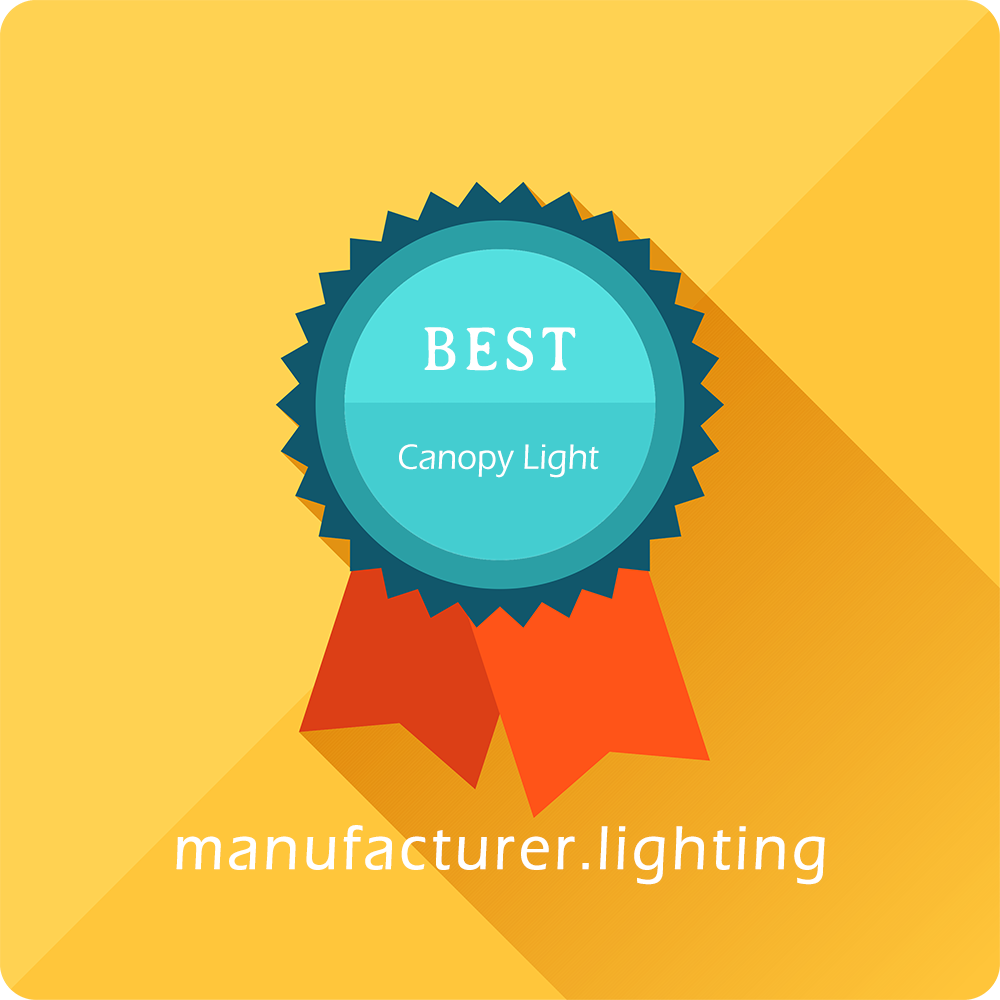
RAB MASI
The MASI LED gas station light delivers today's best-in-class solid-state technology and retail petroleum lighting design you've come to expect from RAB Lighting. A low profile design creates maximum canopy clearance and facilitates effective heat dissipation. The luminaire is designed for standard 4-inch hole installations in new construction projects and also accommodates retrofit installations in openings from 4 to 6.5 inches in diameter. The UL wet location rated fixture is engineered to survive the harshest environmental conditions and exposure to high, repeated vibration.
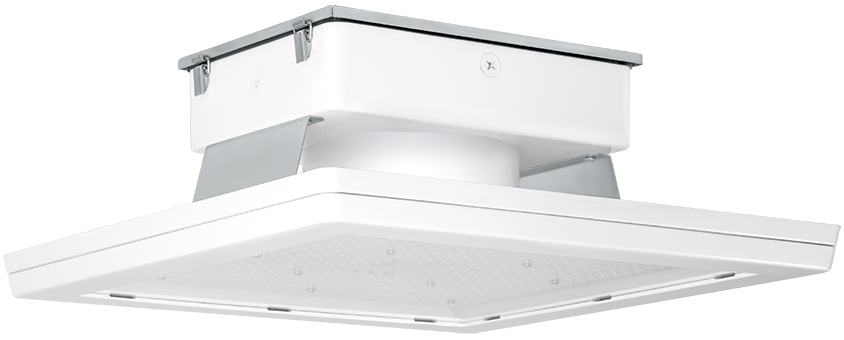
LSI SCOTTSDALE VERTEX
The SCOTTSDALE VERTEX from LSI Industries is the most feature-rich canopy fixture on the market. Rugged low-profile die-cast aluminum housing, optical unit, and driver cover. Silicone optics do not yellow or crack with age and provide a minimum light transmittance of 93%. High-performance driver features over-voltage, under-voltage, short-circuit and over temperature protection. IP66 rated optical unit protects integral components from dust and powerful water jets from any direction. Designed for lighter than air fuel applications. The surface temperature of this product will not rise above 100°C., within a 40°C ambient. Optional integral passive infrared motion and daylight sensor activates switching of luminaire light levels. The AirLink integrated controller is a California Title 24 compliant lighting controller that provides real-time light monitoring and control with utility-grade power monitoring.
